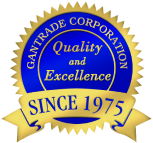Based on its unique structural characteristics, XYLink P-1000 polyether diamine curative delivers exceptional benefits and improved performance in epoxy systems.
The polyether backbone is PTMEG, contributing the enhancements usually attributed to this polymeric unit. PTMEG efficiently enhances both flexibility and fracture toughness. The p-aminobenzoate functionality has low reactivity toward epoxy moieties. Thus, epoxy systems based on XYLink P-1000 exhibit relatively low viscosities and cure-rate control that improves casting, coating, adhesion, and impregnation in composite applications. As a slow-reacting diamine (tetrafunctional epoxy hardener), XYLink P-1000 is effective in applications where long working times, low viscosities, substrate wettability and lower heat-build are required.
Features and Benefits
Epoxy resins are typically brittle materials that exhibit a low-impact toughness and low resistance to crack propagation in high-performance applications. The standard approach to improve fracture toughness is to incorporate an impact modifier, which creates a dispersed phase in the epoxy resin. The addition of high viscosity dispersed phase modifiers in an epoxy resin raises the viscosity of the system, which is a critical parameter during processing and coating.
Gantrade’s XYLink P-1000 is a curative for epoxy resins that will improve fracture toughness without increasing viscosity. XYLink P-1000 will also improve processability.
Since it’s a liquid, processors can mix XYLink P-1000 directly into epoxy resins as a flexibilizing curative, because of its low reactivity and miscibility characteristics. This curative will improve processability by extending the pot life. Processors can accomplish final curing at higher temperatures or with long aging times at room temperature. With a room temperature cure, the addition of XYLink P-1000 diminishes the shrinkage ratio.
In mixing, processors may use a cure accelerator like N,N-4-dimethylaminopyridine (DMPA) or an imidazole. XYLink P-1000 has a unique PTMEG-based backbone; this curative structure results in properties not obtainable with other epoxy curatives. Click the following link to see where we have delineated the attributes of using PTMEG as the soft segment as well.
In epoxy coating resins, low brittleness is a requirement, and low viscosity facilitates workability at ambient temperatures, substrate wetting and self-leveling. XYLink P-1000 is a highly flexible latent amine curative of choice for this reason, while also contributing to low-emissions (low VOCs) by reducing the need for volatile thinners.
The US Navy Center for Corrosion Service & Engineering reported on an enhanced performance coating based on P-1000 and a novolac epoxy resin. This formulation showed good service life as a corrosion protection coating on an actual ship rudder. The P-1000/ novolac epoxy resin exhibited good pot life, was sprayable, and could be brush/roll-coated. The coating remained in great condition after one-year of service at sea. See http://www.dtic.mil/dtic/tr/fulltext/u2/a544229.pdf for more details.
The chemical structure of Gantrade’s P-1000 is shown below. The n value for the PTMEG segment is 13-14 in the P-1000; the theoretical molecular weight is 1238. The carbonyl linkage on the aromatic amine is “electron-withdrawing,” and thus reduces the activity of the amine functionality. This is another unique feature of the XYLink P-1000.

XYLink P-1000 Specifications:
| Item | Specifications |
| CAS Number | 54667-43-5 |
| Appearance at 25°C | Clear amber to brown liquid |
| Metling Point, °C | 18 |
| Amine Hydrogen Equivalent Weight (AHEW), by titration |
330-370 |
| Viscosity, mPa.s @ 30°C | 3000-4800 |
| Moisture Content, ppm | ≤ 500 |
The attributes of the P-1000 curative include the following:
- Low, controlled reactivity and a wide processing latitude with epoxy resins at ambient temperatures; long pot lives; accelerators can be used.
- The low peak exotherm temperatures due to the reduced reactivity allows processing of large parts without excess heat development in the part interior.
- P-1000 is a liquid at room temperature
- Contributes the benefits of the PTMEG soft-segment, including excellent resiliency/rebound properties, good tensile and tear strengths, toughness, abrasion resistance and low temperature performance.
- Good flexibility and impact resistance at low temperatures.
- Hydrolysis and chemical resistance.
- A low order of toxicity.
Gantrade also markets P-650, based on PTMEG 650 and P-2000, based on PTMEG 2000. Both of these products are solids at room temperature. The P-650 results in higher hardness in the cured resin and the P-2000 affords lower hardness values coupled with higher flexibility. Gantrade also markets XYLink 740M, based on the di-p-aminobenzoate from 1,3-propanediol.
Formulation and Stoichiometry Basics
XYLink P-1000 is a tetra-functional aromatic diamine, with four active amine-hydrogen positions. Due to steric factors and glassy state cure kinetics, the rate of cure slows dramatically for the third and fourth active amine-hydrogens. Thus, processors must use heat and extended cure times to complete the curing process after vitrification.
With typical bisphenol A, F and novolac glycidyl-type resins, each molecule of the XYLink P-1000 diamine, can react with four glycidyl-oxirane moieties of the epoxy. In order to achieve full cure, it is usually necessary to increase the process temperature after gelation. Processors often base epoxy formulations on 100 parts by weight (pbw) of the epoxy resin. To calculate the amount of P-1000 required to cure 100 pbw of the epoxy resin, use the following equation.
Parts of P-1000 = (AHEW ÷ EEW) x 100
Where AHEW is the amine hydrogen equivalent weight of the curative, i.e.330-370 for the XYLink P-1000 and EEW is the epoxy equivalent weight of the epoxy resin. The amine equivalent weight will be provided on the COA of the XYLink P-1000. Divide this value by two, since there are two active hydrogen positions on each amine function.
You can tolerate some deviation from exact stoichiometry in a formulation with minimal effects on the cured properties of the final product. We recommend some experimentation to ascertain the influence of deviation from the exact stoichiometry on the critical performance parameters.
The times to peak exotherm for a part or to dryness in a coating are multiple hours to days without an accelerator, and multiple hours with an accelerator. Raising the temperature decreases the cure times.
Applications
Applications for epoxy systems cured with XYLink P-1000 include structural parts, fiber-reinforced prepreg and composites, filament winding, corrosion protective coatings, electronic packaging, potting and encapsulation, as well as high-performance adhesives. With glycidyl type epoxy resins, XYLink P-1000 produces excellent protective coatings which are tough, flexible, and resistant to impact, corrosion, and abrasion.
Packaging
Gantrade offers the P-1000 in galvanized iron or plastic drums, with a net weight of 20 Kg., 50 Kg. and 200 Kg. Sample quantities are generally 1 Kg. in size.
Our company recommends a thorough review of our SDS prior to handling these curatives, in addition to observance of the correct safety precautions and handling requirements. You should store the diamines in a well-ventilated and dry location. Keep P-1000 products away from sunlight.
Conclusion
With its unique structure, liquid XYLink P-1000 brings versatility of applications to the world of epoxy resins. With a PTMEG backbone, XYLink P-1000 delivers on the promise of the PTMEG soft-segment, including good tensile, flexural and tear strengths, toughness, crack and abrasion resistance, and low temperature performance. The p-aminobenzoate functionality affords excellent cure-rate control and other processing benefits. Thus, XYLink P-1000 is an ideal curative for many epoxy resin applications and simply achieves attributes that other curatives can’t reach.
For more information on the XYLink family of curatives for optimizing epoxy systems, contact Gantrade today. Gantrade provides experienced technical support, working with our customers to solve problems and to develop unique products.


















